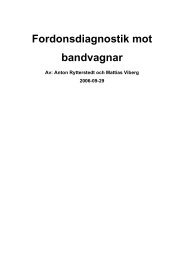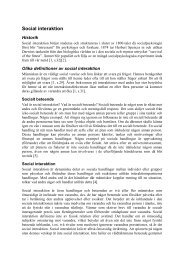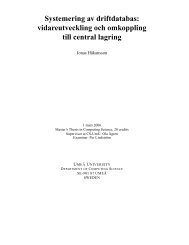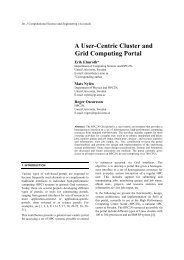Integrated Systems and their Impact on the Future of Positioning ...
Integrated Systems and their Impact on the Future of Positioning ...
Integrated Systems and their Impact on the Future of Positioning ...
You also want an ePaper? Increase the reach of your titles
YUMPU automatically turns print PDFs into web optimized ePapers that Google loves.
<str<strong>on</strong>g>Integrated</str<strong>on</strong>g> <str<strong>on</strong>g>Systems</str<strong>on</strong>g> <str<strong>on</strong>g>and</str<strong>on</strong>g> <str<strong>on</strong>g><strong>the</strong>ir</str<strong>on</strong>g> <str<strong>on</strong>g>Impact</str<strong>on</strong>g> <strong>on</strong> <strong>the</strong> <strong>Future</strong> <strong>of</strong> Positi<strong>on</strong>ing,<br />
Navigati<strong>on</strong>, <str<strong>on</strong>g>and</str<strong>on</strong>g> Mapping Applicati<strong>on</strong>s<br />
Dr. Naser EL-SHEIMY<br />
Key words: GPS, Inertial <str<strong>on</strong>g>Systems</str<strong>on</strong>g>, Navigati<strong>on</strong>al Aid, Visi<strong>on</strong>-Based <str<strong>on</strong>g>Systems</str<strong>on</strong>g><br />
ABSTRACT<br />
The Global Positi<strong>on</strong>ing System (GPS) is a c<strong>on</strong>stellati<strong>on</strong> <strong>of</strong> satellites that broadcast<br />
signals that can be used to derive precise timing, locati<strong>on</strong>, <str<strong>on</strong>g>and</str<strong>on</strong>g> velocity informati<strong>on</strong>.<br />
The derived informati<strong>on</strong> (time, positi<strong>on</strong>, <str<strong>on</strong>g>and</str<strong>on</strong>g> velocity) may be combined with o<strong>the</strong>r<br />
systems such as communicati<strong>on</strong>s devices, computers, <str<strong>on</strong>g>and</str<strong>on</strong>g> s<strong>of</strong>tware to perform a variety<br />
<strong>of</strong> tasks. The Global Positi<strong>on</strong>ing System (GPS) is capable <strong>of</strong> providing all range<br />
positi<strong>on</strong>ing accuracy in all situati<strong>on</strong>s where uninterrupted signal recepti<strong>on</strong> is possible<br />
<str<strong>on</strong>g>and</str<strong>on</strong>g> <strong>the</strong> general satellite geometry is within acceptable limits. It is also evident that o<strong>the</strong>r<br />
navigati<strong>on</strong> technologies, such as Inertial Navigati<strong>on</strong> <str<strong>on</strong>g>Systems</str<strong>on</strong>g> (INS), are currently not<br />
capable <strong>of</strong> providing similar accuracies at a comparable price, i.e. <strong>the</strong>re is no real<br />
competiti<strong>on</strong> to GPS in a scenario <strong>of</strong> uninterrupted signal recepti<strong>on</strong>. This leaves two<br />
scenarios to be c<strong>on</strong>sidered. The first <strong>on</strong>e is that <strong>of</strong> intermittent signal recepti<strong>on</strong>, as for<br />
instance in heavily forested areas or in urban centres. The o<strong>the</strong>r <strong>on</strong>e is that <strong>of</strong> no signal<br />
recepti<strong>on</strong> at all, as for instance in buildings, underground or underwater. In <strong>the</strong> first<br />
case, GPS has to be integrated with o<strong>the</strong>r sensors to bridge periods <strong>of</strong> no signal<br />
recepti<strong>on</strong>. In <strong>the</strong> sec<strong>on</strong>d case, GPS has to be replaced by ano<strong>the</strong>r system that can<br />
provide c<strong>on</strong>tinuous navigati<strong>on</strong> in those envir<strong>on</strong>ments where GPS does not work. Both<br />
cases will be treated in this paper where <strong>the</strong> integrati<strong>on</strong> <strong>of</strong> systems <str<strong>on</strong>g>and</str<strong>on</strong>g> navigati<strong>on</strong>al aids<br />
(navaids), will be investigated as an alternative for times <strong>of</strong> no GPS signal recepti<strong>on</strong>. In<br />
terms <strong>of</strong> systems, both INS <str<strong>on</strong>g>and</str<strong>on</strong>g> visi<strong>on</strong>-based systems will be c<strong>on</strong>sidered. In terms <strong>of</strong><br />
navaids, odometers, gyros <str<strong>on</strong>g>and</str<strong>on</strong>g> digital maps will be c<strong>on</strong>sidered for l<str<strong>on</strong>g>and</str<strong>on</strong>g> vehicle<br />
navigati<strong>on</strong>, <str<strong>on</strong>g>and</str<strong>on</strong>g> pedometers, magnetic compasses, digital maps, <str<strong>on</strong>g>and</str<strong>on</strong>g> cellular ph<strong>on</strong>es for<br />
backpack systems.<br />
<str<strong>on</strong>g>Integrated</str<strong>on</strong>g> systems will, <strong>the</strong>refore, provide a system that has superior performance in<br />
comparis<strong>on</strong> with ei<strong>the</strong>r a GPS, an INS, or visi<strong>on</strong>-based st<str<strong>on</strong>g>and</str<strong>on</strong>g>-al<strong>on</strong>e system. For<br />
instance, GPS derived positi<strong>on</strong>s have approximately white noise characteristics over <strong>the</strong><br />
whole frequency range. The GPS-derived positi<strong>on</strong>s <str<strong>on</strong>g>and</str<strong>on</strong>g> velocities are <strong>the</strong>refore<br />
excellent external measurements for updating <strong>the</strong> INS <str<strong>on</strong>g>and</str<strong>on</strong>g> providing <strong>the</strong> imaging<br />
sensors with positi<strong>on</strong> parameters, thus improving its l<strong>on</strong>g-term accuracy. Similarly, <strong>the</strong><br />
INS can provide precise positi<strong>on</strong> <str<strong>on</strong>g>and</str<strong>on</strong>g> velocity data for GPS signal acquisiti<strong>on</strong> <str<strong>on</strong>g>and</str<strong>on</strong>g><br />
reacquisiti<strong>on</strong> after outages <str<strong>on</strong>g>and</str<strong>on</strong>g> <strong>the</strong> orientati<strong>on</strong> parameters for <strong>the</strong> visi<strong>on</strong>-based system.<br />
The visi<strong>on</strong>-based system can be used as a backup navigati<strong>on</strong> system <str<strong>on</strong>g>and</str<strong>on</strong>g> to update <strong>the</strong><br />
INS data if <strong>the</strong> GPS signal is blocked for l<strong>on</strong>g periods. In general, <strong>the</strong> fact that<br />
redundant measurements are available for <strong>the</strong> determinati<strong>on</strong> <strong>of</strong> <strong>the</strong> vehicle trajectory<br />
parameters greatly enhances <strong>the</strong> reliability <strong>of</strong> <strong>the</strong> system.
The paper will cover both, <strong>the</strong> c<strong>on</strong>cept <strong>of</strong> integrati<strong>on</strong> <str<strong>on</strong>g>and</str<strong>on</strong>g> implementati<strong>on</strong> aspects <strong>of</strong><br />
integrated systems. Examples <strong>on</strong> current <str<strong>on</strong>g>and</str<strong>on</strong>g> future systems for mapping, positi<strong>on</strong>ing,<br />
<str<strong>on</strong>g>and</str<strong>on</strong>g> navigati<strong>on</strong> applicati<strong>on</strong>s will be given.<br />
1. INTRODUCTION: CURRENT INTEGRATED POSITIONING AND<br />
NAVIGATION MARKET<br />
The current market <strong>of</strong> integrated positi<strong>on</strong>ing <str<strong>on</strong>g>and</str<strong>on</strong>g> navigati<strong>on</strong> systems is clearly<br />
dominated by those systems that have GPS as <strong>on</strong>e <strong>of</strong> <str<strong>on</strong>g><strong>the</strong>ir</str<strong>on</strong>g> comp<strong>on</strong>ents. Besides being<br />
globally available, GPS provides <strong>the</strong> whole range <strong>of</strong> navigati<strong>on</strong> accuracies at very low<br />
cost. It is also highly portable, has low power c<strong>on</strong>sumpti<strong>on</strong>, <str<strong>on</strong>g>and</str<strong>on</strong>g> is well suited for<br />
integrati<strong>on</strong> with o<strong>the</strong>r sensors, communicati<strong>on</strong> links, <str<strong>on</strong>g>and</str<strong>on</strong>g> databases. At this point in <strong>the</strong><br />
development <strong>of</strong> navigati<strong>on</strong> technology, <strong>the</strong> need for alternative positi<strong>on</strong>ing systems <strong>on</strong>ly<br />
arises because GPS does not work in all envir<strong>on</strong>ments.<br />
Figure (1) shows <strong>the</strong> projected development <strong>of</strong> GPS module cost. For <strong>the</strong> accuracy<br />
range c<strong>on</strong>sidered here, it has reached <strong>the</strong> unit price <strong>of</strong> about $100 <str<strong>on</strong>g>and</str<strong>on</strong>g> predicti<strong>on</strong>s are<br />
that it will drop to about $50 by 2005 when, most likely, it will level <strong>of</strong>f. Module cost<br />
are not equivalent to system cost, but <strong>the</strong> recent development <strong>of</strong> navigati<strong>on</strong> receivers at<br />
a price <strong>of</strong> a few hundred dollars shows clearly that module cost are an important factor.<br />
Even more important is <strong>the</strong> fact that with unit cost that low, GPS is becoming a<br />
commodity, comparable to a S<strong>on</strong>y Walkman, pocket calculators, or a digital wristwatch.<br />
Thus, pers<strong>on</strong>al GPS devices will so<strong>on</strong> start to drive <strong>the</strong> module market <str<strong>on</strong>g>and</str<strong>on</strong>g> provide<br />
navigati<strong>on</strong> receivers <strong>of</strong> high versatility at even lower cost.<br />
U.S. $<br />
600<br />
500<br />
400<br />
300<br />
200<br />
100<br />
0<br />
1994<br />
1995<br />
1996<br />
1997<br />
1998<br />
1999<br />
2000<br />
1 centimeter<br />
1 meter<br />
10 meter<br />
100 meter<br />
2001<br />
2002<br />
2003<br />
Figure 1: Price Development <strong>of</strong> GPS Module Cost by Accuracy<br />
(After NAPA/NRC, 1995)<br />
C<strong>on</strong>sidering <strong>the</strong>se market projecti<strong>on</strong>s shown in Figure (1), it is very difficult for any<br />
o<strong>the</strong>r positi<strong>on</strong>ing <str<strong>on</strong>g>and</str<strong>on</strong>g> navigati<strong>on</strong> technology that to compete with GPS (Schwarz <str<strong>on</strong>g>and</str<strong>on</strong>g> El-<br />
Sheimy, 1999). Therefore, o<strong>the</strong>r navigati<strong>on</strong> technologies would typically be developed<br />
for 'n<strong>on</strong>-GPS' envir<strong>on</strong>ments, i.e. for envir<strong>on</strong>ments where GPS does not functi<strong>on</strong> at all<br />
(underground, underwater, in buildings) or where it performs poorly (forested areas,
urban envir<strong>on</strong>ments). Although <strong>the</strong>re is still a substantial navigati<strong>on</strong> market for 'n<strong>on</strong>-<br />
GPS' envir<strong>on</strong>ments, it is much smaller than <strong>the</strong> <strong>on</strong>e predicted for GPS. In <strong>the</strong> porti<strong>on</strong> <strong>of</strong><br />
<strong>the</strong> market where GPS is <strong>on</strong>ly available for part <strong>of</strong> <strong>the</strong> time, <strong>the</strong> questi<strong>on</strong> will be 'how<br />
much is <strong>the</strong> user willing to pay for a c<strong>on</strong>tinuous navigati<strong>on</strong> soluti<strong>on</strong>'? This obviously<br />
will depend <strong>on</strong> <strong>the</strong> specific applicati<strong>on</strong> <str<strong>on</strong>g>and</str<strong>on</strong>g> it might be possible that niche markets will<br />
develop around such applicati<strong>on</strong>s. <str<strong>on</strong>g>Integrated</str<strong>on</strong>g> soluti<strong>on</strong>s will be <strong>of</strong> high interest in such<br />
applicati<strong>on</strong>s, <str<strong>on</strong>g>and</str<strong>on</strong>g> may involve sensor integrati<strong>on</strong> as well as data base integrati<strong>on</strong> for<br />
applicati<strong>on</strong>s such as map matching. In those applicati<strong>on</strong>s where GPS does not work at<br />
all, <strong>the</strong> search for cost-effective alternatives will c<strong>on</strong>tinue.<br />
One promising development is <strong>the</strong> emergence <strong>of</strong> Micro-Electro-Mechanical <str<strong>on</strong>g>Systems</str<strong>on</strong>g><br />
(MEMS) technology. MEMS is an enabling technology with a massive global market,<br />
predicted to be at 140 billi<strong>on</strong> US $ in 2002. This means that it will have about 7 times<br />
<strong>the</strong> market size <strong>of</strong> GPS at that time. A small porti<strong>on</strong> <strong>of</strong> this market, about 2%, will<br />
support inertial sensor technology. Since INS technology is capable <strong>of</strong> working in all<br />
envir<strong>on</strong>ments where GPS has difficulties, MEMS inertial technology is seen as both a<br />
possible complement <strong>of</strong> GPS technology <str<strong>on</strong>g>and</str<strong>on</strong>g> a potential alternative to GPS if market<br />
volumes develop in <strong>the</strong> way anticipated, for more details see DARPA (1998), <str<strong>on</strong>g>and</str<strong>on</strong>g> U.S.<br />
D.o.D. (1995).<br />
Besides <strong>the</strong> MEMS technology development, <strong>the</strong>re is also an increasing trend towards<br />
integrated systems. The integrati<strong>on</strong> <strong>of</strong> GPS with low-cost IMUs has already reached <strong>the</strong><br />
product stage. Such systems can ei<strong>the</strong>r be used as a highly reliable navigati<strong>on</strong> systems,<br />
giving positi<strong>on</strong>, velocity, <str<strong>on</strong>g>and</str<strong>on</strong>g> attitude with high accuracy, or as a georeferencing<br />
systems for various imaging sensors (optical or digital cameras, laser scanners,<br />
multispectral scanners). Integrati<strong>on</strong> <strong>of</strong> low-cost sensors, specifically for backpack<br />
systems has also made c<strong>on</strong>siderable advances. The use <strong>of</strong> visi<strong>on</strong>-based systems in<br />
c<strong>on</strong>juncti<strong>on</strong> with low-cost positi<strong>on</strong> <str<strong>on</strong>g>and</str<strong>on</strong>g> attitude sensors may become a viable alternative<br />
in cities if current advances in enabling technologies c<strong>on</strong>tinue. Specifically <strong>the</strong><br />
development <strong>of</strong> digital cameras <strong>on</strong> a C-MOS chip, <strong>the</strong> availability <strong>of</strong> inexpensive<br />
storage devices <strong>of</strong> Gigabyte capacity, <str<strong>on</strong>g>and</str<strong>on</strong>g> <strong>the</strong> increase in computer speed to 1000 MHz.<br />
Will c<strong>on</strong>tribute to <strong>the</strong> emergence <strong>of</strong> low-cost visi<strong>on</strong>-based systems (Schwarz <str<strong>on</strong>g>and</str<strong>on</strong>g> El-<br />
Sheimy, 1999).<br />
2. STATUS OF CURRENT INTEGRATED SYSTEMS<br />
The GPS is capable <strong>of</strong> providing positi<strong>on</strong>ing <str<strong>on</strong>g>and</str<strong>on</strong>g> navigati<strong>on</strong> paramters in all situati<strong>on</strong>s<br />
where uninterrupted signal recepti<strong>on</strong> is possible <str<strong>on</strong>g>and</str<strong>on</strong>g> <strong>the</strong> general satellite geometry is<br />
within acceptable limits. It is also evident that o<strong>the</strong>r navigati<strong>on</strong> technologies are<br />
currently not capable <strong>of</strong> providing similar accuracies at a comparable price, i.e. <strong>the</strong>re is<br />
not real competiti<strong>on</strong> to GPS in a scenario <strong>of</strong> uninterrupted signal recepti<strong>on</strong>. This leaves<br />
two scenarios to be c<strong>on</strong>sidered. The first <strong>on</strong>e is that <strong>of</strong> intermittent signal recepti<strong>on</strong>, as<br />
for instance in heavily forested areas or in urban centres. The o<strong>the</strong>r <strong>on</strong>e is that <strong>of</strong> no<br />
signal recepti<strong>on</strong> at all, as for instance in buildings, underground or underwater. In <strong>the</strong><br />
first case, GPS has to be integrated with o<strong>the</strong>r navaid sensors to bridge periods <strong>of</strong> no<br />
signal recepti<strong>on</strong>. In <strong>the</strong> sec<strong>on</strong>d case, GPS has to be replaced by ano<strong>the</strong>r system that can<br />
provide c<strong>on</strong>tinuous navigati<strong>on</strong> in those envir<strong>on</strong>ments where GPS does not work. In<br />
terms <strong>of</strong> systems, both INS <str<strong>on</strong>g>and</str<strong>on</strong>g> visi<strong>on</strong>-based systems (mainly for robotics applicati<strong>on</strong>s)<br />
are <strong>the</strong> most comm<strong>on</strong>ly used systems. In terms <strong>of</strong> navaids, odometers, gyros <str<strong>on</strong>g>and</str<strong>on</strong>g> digital
maps will be c<strong>on</strong>sidered for l<str<strong>on</strong>g>and</str<strong>on</strong>g> vehicle navigati<strong>on</strong>, <str<strong>on</strong>g>and</str<strong>on</strong>g> pedometers, magnetic<br />
compasses, digital maps, <str<strong>on</strong>g>and</str<strong>on</strong>g> cellular ph<strong>on</strong>es for backpack systems.<br />
The integrati<strong>on</strong> <strong>of</strong> <strong>the</strong> navigati<strong>on</strong> technologies (GPS, INS, <str<strong>on</strong>g>and</str<strong>on</strong>g> visi<strong>on</strong>-based<br />
technologies) with navaids provides a system that has superior performance in<br />
comparis<strong>on</strong> with ei<strong>the</strong>r a GPS, an INS, or visi<strong>on</strong>-based st<str<strong>on</strong>g>and</str<strong>on</strong>g>-al<strong>on</strong>e system. For<br />
instance, GPS derived positi<strong>on</strong>s have approximately white noise characteristics over <strong>the</strong><br />
whole frequency range. The GPS-derived positi<strong>on</strong>s <str<strong>on</strong>g>and</str<strong>on</strong>g> velocities are <strong>the</strong>refore<br />
excellent external measurements for updating <strong>the</strong> INS <str<strong>on</strong>g>and</str<strong>on</strong>g> providing <strong>the</strong> imaging<br />
sensors with positi<strong>on</strong> parameters, thus improving its l<strong>on</strong>g-term accuracy. Similarly, <strong>the</strong><br />
INS can provide precise positi<strong>on</strong> <str<strong>on</strong>g>and</str<strong>on</strong>g> velocity data for GPS signal acquisiti<strong>on</strong> <str<strong>on</strong>g>and</str<strong>on</strong>g><br />
reacquisiti<strong>on</strong> after outages <str<strong>on</strong>g>and</str<strong>on</strong>g> <strong>the</strong> orientati<strong>on</strong> parameters for <strong>the</strong> visi<strong>on</strong>-based system.<br />
The visi<strong>on</strong>-based system can be used as a backup navigati<strong>on</strong> system <str<strong>on</strong>g>and</str<strong>on</strong>g> to update <strong>the</strong><br />
INS data if <strong>the</strong> GPS signal is blocked for l<strong>on</strong>g periods. In general, <strong>the</strong> fact that<br />
redundant measurements are available for <strong>the</strong> determinati<strong>on</strong> <strong>of</strong> <strong>the</strong> vehicle trajectory<br />
parameters greatly enhances <strong>the</strong> reliability <strong>of</strong> <strong>the</strong> system.<br />
The navigati<strong>on</strong> states vector (positi<strong>on</strong>, velocity, <str<strong>on</strong>g>and</str<strong>on</strong>g> attitude) can be determined by<br />
judicially combining elements <strong>of</strong>: navigati<strong>on</strong> technologies (e.g. GPS, Inertial, <str<strong>on</strong>g>and</str<strong>on</strong>g><br />
visi<strong>on</strong>-based) <str<strong>on</strong>g>and</str<strong>on</strong>g> navigati<strong>on</strong> aids (e.g. distance, velocity, <str<strong>on</strong>g>and</str<strong>on</strong>g> attitude sensors). This is<br />
shown in Figure (2) where <strong>the</strong> navigati<strong>on</strong> technologies <str<strong>on</strong>g>and</str<strong>on</strong>g> navaids are listed in two<br />
blocks. Table (1) lists current <str<strong>on</strong>g>and</str<strong>on</strong>g> possible integrated systems scenarios. Table (2) lists<br />
which sub-vectors <strong>of</strong> <strong>the</strong> Navigati<strong>on</strong> State that can be obtained with <strong>the</strong>se systems<br />
scenarios <str<strong>on</strong>g>and</str<strong>on</strong>g> which characteristics <str<strong>on</strong>g>and</str<strong>on</strong>g> <strong>the</strong> resulting integrated system will have.<br />
Possible applicati<strong>on</strong>s are <strong>the</strong>n given in <strong>the</strong> last column.<br />
The Tables indicate that a wide variety <strong>of</strong> integrati<strong>on</strong> strategies can be implemented.<br />
Each has its own characteristics <str<strong>on</strong>g>and</str<strong>on</strong>g> <strong>the</strong> choice <strong>of</strong> a specific system will be based <strong>on</strong><br />
system requirements <str<strong>on</strong>g>and</str<strong>on</strong>g> applicati<strong>on</strong>s. Although it is possible to integrate any set <strong>of</strong><br />
technologies, <strong>the</strong> integrati<strong>on</strong> <strong>of</strong> GPS <str<strong>on</strong>g>and</str<strong>on</strong>g> INS represents <strong>the</strong> core <strong>of</strong> for any integrated<br />
systems where reliability <str<strong>on</strong>g>and</str<strong>on</strong>g> versatility are <strong>the</strong> major issues. The low cost <strong>of</strong> GPS<br />
receivers, <strong>the</strong> coverage <str<strong>on</strong>g>and</str<strong>on</strong>g> reliability <strong>of</strong> GPS, <str<strong>on</strong>g>and</str<strong>on</strong>g> <strong>the</strong> expected decrease in cost <strong>of</strong><br />
MEMS-based inertial sensors make GPS <str<strong>on</strong>g>and</str<strong>on</strong>g> INS <strong>the</strong> logical technologies for realizing<br />
<strong>the</strong> benefits <strong>of</strong>fered by integrated positi<strong>on</strong>ing systems. Many companies are currently<br />
working <strong>on</strong> <strong>the</strong> integrati<strong>on</strong> <strong>of</strong> MEMS based IMU with GPS, with projecti<strong>on</strong>s <strong>of</strong> size,<br />
weight <str<strong>on</strong>g>and</str<strong>on</strong>g> power at 2 x 2 x 0.5 cm, 5 g, <str<strong>on</strong>g>and</str<strong>on</strong>g> less than 1 W for implementati<strong>on</strong> at <strong>the</strong><br />
ASIC level. Figure 3, shows typical performances for some <strong>of</strong> <strong>the</strong> scenarios listed in<br />
Table 1.
Scenario<br />
Current <str<strong>on</strong>g>Systems</str<strong>on</strong>g><br />
Possible <str<strong>on</strong>g>Systems</str<strong>on</strong>g><br />
Full Navigati<strong>on</strong> Soluti<strong>on</strong>:<br />
Satellites RF Ranging (SRF)<br />
(e.g GPS, GLONASS, DGPS,<br />
WADGPS)<br />
Terrestrial RF (TRF) Ranging<br />
(e.g. Cellular, Paging,<br />
AM/FM)<br />
Inertial Navigati<strong>on</strong> <str<strong>on</strong>g>Systems</str<strong>on</strong>g> (INS)<br />
Visi<strong>on</strong> Based <str<strong>on</strong>g>Systems</str<strong>on</strong>g> (VB)<br />
Fusi<strong>on</strong><br />
Navigati<strong>on</strong> Aid<br />
Attitude<br />
magnetic compass (C)<br />
Differential Odometery (O)<br />
Gyros (G)<br />
Velocity (positi<strong>on</strong>)<br />
Accelerometer<br />
Laser (L)<br />
Speedometer (O)<br />
Distance<br />
Odometer (O)<br />
Pedometer (P)<br />
Laser (L)<br />
Map Matching (MM)<br />
<str<strong>on</strong>g>Integrated</str<strong>on</strong>g> <str<strong>on</strong>g>Systems</str<strong>on</strong>g><br />
Figure 2: C<strong>on</strong>cept <strong>of</strong> Integrating Navigati<strong>on</strong> <str<strong>on</strong>g>Systems</str<strong>on</strong>g> <str<strong>on</strong>g>and</str<strong>on</strong>g> Navaids.<br />
Table 1: <str<strong>on</strong>g>Integrated</str<strong>on</strong>g> <str<strong>on</strong>g>Systems</str<strong>on</strong>g> Scenarios<br />
Navigati<strong>on</strong> <str<strong>on</strong>g>Systems</str<strong>on</strong>g> Navigati<strong>on</strong> Aids (navaids)<br />
SRF TRF VB IN<br />
S<br />
MM L O P C G A<br />
Applicati<strong>on</strong><br />
Vehicle<br />
Backpac<br />
k<br />
1 √ √ √ √<br />
2 √ √ √ √<br />
3 √ √ √ √<br />
4 √ √ √<br />
5 √ √ √ √<br />
6 √ √ √ √ √<br />
7 √ √ √ √ √<br />
8 √√√√ √√√√ √√√√ √√√√<br />
9 √√√√ √√√√ √√√√ √√√√ √√√√<br />
10* √√√√ √√√√ √√√√<br />
11 √√√√ √√√√ √√√√ √√√√<br />
12 √√√√ √√√√ √√√√<br />
13 √√√√ √√√√ √√√√ √√√√<br />
14 √√√√ √√√√ √√√√ √√√√ √√√√
Scenario<br />
Table 2: Characterstics, Lmitati<strong>on</strong>s, <str<strong>on</strong>g>and</str<strong>on</strong>g> Applicati<strong>on</strong>s <strong>of</strong> <str<strong>on</strong>g>Systems</str<strong>on</strong>g> Scenarios<br />
Navigati<strong>on</strong> State Characteristics/Current<br />
Applicati<strong>on</strong>s<br />
r(t) v(t) R(t)<br />
Limitati<strong>on</strong>s<br />
Vehicle Backpack<br />
1 √ √ • Low cost/lightweight system<br />
• Signal blockage in urban<br />
centers<br />
2 √ √ √ • Works in all envir<strong>on</strong>ments<br />
• High Cost/Weight<br />
3 √ √ √ • Works in all envir<strong>on</strong>ments<br />
• High Cost/Weight<br />
4 √ √ • Low cost/lightweight system<br />
• Signal blockage in urban<br />
centers<br />
5 √ √ √* • Low cost/lightweight system<br />
• Provides heading <strong>on</strong>ly<br />
• Signal blockage in urban<br />
centers<br />
6 √ √ • Low cost/lightweight system<br />
• Signal blockage in urban<br />
centers<br />
7 √ √ √* • Static mode <strong>of</strong> operati<strong>on</strong> for<br />
backpack<br />
• Provides heading <strong>on</strong>ly<br />
8 √ √ √* • Static mode <strong>of</strong> operati<strong>on</strong><br />
• Provides heading <strong>on</strong>ly<br />
9 √ √ √* • Static mode <strong>of</strong> operati<strong>on</strong><br />
• Heading <strong>on</strong>ly<br />
10 √ √ • Low cost/lightweight system<br />
• Signal blockage in urban<br />
centers<br />
11 √ √ √* • Provides heading <strong>on</strong>ly<br />
• Signal blockage in urban<br />
centers<br />
12 √ • Low cost/lightweight system<br />
• Local coverage<br />
• Provides heading <strong>on</strong>ly<br />
13 √ √* • Low cost/lightweight system<br />
• Local coverage<br />
• Provides heading <strong>on</strong>ly<br />
14 √ √ √* • Low cost/lightweight system<br />
• Local coverage<br />
• Provides heading <strong>on</strong>ly<br />
Car navigati<strong>on</strong><br />
Fleet<br />
Management<br />
Military<br />
Navigati<strong>on</strong><br />
Mapping<br />
Highway<br />
inventory<br />
systems<br />
Car navigati<strong>on</strong><br />
Car navigati<strong>on</strong><br />
Mapping<br />
applicati<strong>on</strong>s<br />
Car navigati<strong>on</strong><br />
Car navigati<strong>on</strong><br />
Car navigati<strong>on</strong><br />
Hikers<br />
Rescue<br />
operati<strong>on</strong>s<br />
Seismic<br />
Applicati<strong>on</strong>s<br />
Navigati<strong>on</strong><br />
Mapping<br />
applicati<strong>on</strong>s<br />
Mapping<br />
applicati<strong>on</strong>s<br />
Target<br />
tracking<br />
Targeting<br />
tracking<br />
Navigati<strong>on</strong>
• Provides heading <strong>on</strong>ly<br />
GPS<br />
INS<br />
Terrestrial Radio<br />
GPS + INS<br />
DR + MM<br />
DR + MM + VB<br />
GPS+ DR + MM<br />
GPS+ DR + MM + VB<br />
DGPS<br />
WAAS GPS<br />
5 min ZUPTs<br />
0 25 50 75 100<br />
DR : Dead Reck<strong>on</strong>ing (Gyro + Odometer)<br />
VB : Visi<strong>on</strong> Based<br />
MM : Map Matching<br />
125 150<br />
Figure 3: Performance Comparis<strong>on</strong>s <strong>of</strong> Various <str<strong>on</strong>g>Integrated</str<strong>on</strong>g> <str<strong>on</strong>g>Systems</str<strong>on</strong>g><br />
3. FUTURE TRENDS<br />
The trend towards integrated systems in positi<strong>on</strong>ing <str<strong>on</strong>g>and</str<strong>on</strong>g> navigati<strong>on</strong> is fuelled by <strong>the</strong><br />
dem<str<strong>on</strong>g>and</str<strong>on</strong>g> for high accuracy, lightweight, low cost, <str<strong>on</strong>g>and</str<strong>on</strong>g> by technological developments<br />
which satisfy this dem<str<strong>on</strong>g>and</str<strong>on</strong>g>. Three developments are especially important in this c<strong>on</strong>text:<br />
<strong>the</strong> progress in MEMS based INS systems, future enhancement to GPS, <str<strong>on</strong>g>and</str<strong>on</strong>g> future<br />
trends <strong>of</strong> visi<strong>on</strong>-based systems <str<strong>on</strong>g>and</str<strong>on</strong>g> map matching. There is no questi<strong>on</strong> that that GPS<br />
will be part <strong>of</strong> any future integrated system, if GPS signals can be received for at least<br />
part <strong>of</strong> <strong>the</strong> time<br />
The Progress in MEMS Technology: The Progress in MEMS Technology will enable<br />
in <strong>the</strong> near future complete inertial navigati<strong>on</strong> units <strong>on</strong> a chip, composed <strong>of</strong> multiple<br />
integrated MEMS accelerometers <str<strong>on</strong>g>and</str<strong>on</strong>g> gyroscopes. In additi<strong>on</strong> to single-chip inertial<br />
navigati<strong>on</strong> units, <strong>the</strong>re are many opportunities for MEMS inserti<strong>on</strong> into low-power,<br />
high-resoluti<strong>on</strong>, small-area displays <str<strong>on</strong>g>and</str<strong>on</strong>g> mass data storage devices for storage densities<br />
<strong>of</strong> terabytes per square centimeter. These opportunities are essential if visi<strong>on</strong> based<br />
systems are to be fully integrated into a backpack integrated navigati<strong>on</strong> system.<br />
Figure (4) relates <strong>the</strong> predicted development <strong>of</strong> MEMS-based inertial sensors to three<br />
major performance parameters - bias, scale factor <str<strong>on</strong>g>and</str<strong>on</strong>g> noise. These parameters are<br />
usually c<strong>on</strong>sidered when judging system accuracy. They show that, for <strong>the</strong> medium<br />
term, two c<strong>on</strong>clusi<strong>on</strong>s are possible at this time. First, MEMS-based inertial sensors will<br />
in general reach higher performance levels than <strong>the</strong> MEMS-based IMU-<strong>on</strong>-a-chip. This<br />
simply indicates that performance is dependent <strong>on</strong> <strong>the</strong> physical dimensi<strong>on</strong>s <strong>of</strong> <strong>the</strong> sensor<br />
or system. Sec<strong>on</strong>d, it appears possible that MEMS-based tactical IMUs will become a<br />
reality within a ten year time frame, but that navigati<strong>on</strong>-grade systems are ra<strong>the</strong>r<br />
unlikely during that period. For more details see Schwarz <str<strong>on</strong>g>and</str<strong>on</strong>g> El-Sheimy (1999),<br />
Barbour (1996), <str<strong>on</strong>g>and</str<strong>on</strong>g> Allen et. al. (1998).
Figure 4: Predicted Development <strong>of</strong> MEMS-Based Inertial Sensors<br />
The <strong>Future</strong> Enhancement <strong>of</strong> GPS: The proposed enhancements to GPS have <strong>the</strong><br />
comm<strong>on</strong> goal <strong>of</strong> increasing both <strong>the</strong> capability <str<strong>on</strong>g>and</str<strong>on</strong>g> robustness <strong>of</strong> <strong>the</strong> system. The<br />
possible major modificati<strong>on</strong>s to <strong>the</strong> system include <strong>the</strong> removal <strong>of</strong> <strong>the</strong> intenti<strong>on</strong>al<br />
degradati<strong>on</strong> <strong>of</strong> <strong>the</strong> signals (SA), <strong>the</strong> introducti<strong>on</strong> <strong>of</strong> new signals, improvements in <strong>the</strong><br />
c<strong>on</strong>trol segment functi<strong>on</strong>s <str<strong>on</strong>g>and</str<strong>on</strong>g> increases in <strong>the</strong> size <strong>of</strong> <strong>the</strong> GPS c<strong>on</strong>stellati<strong>on</strong>. The<br />
potential effects <strong>of</strong> <strong>the</strong>se have been lumped toge<strong>the</strong>r <str<strong>on</strong>g>and</str<strong>on</strong>g> are shown in Figure (4). It is<br />
estimated that <strong>the</strong>y will improve <strong>the</strong> 2DRMS to about 9.5m. These are l<strong>on</strong>g term goals<br />
<str<strong>on</strong>g>and</str<strong>on</strong>g> no firm commitments have yet been made.<br />
Accuracy (m)<br />
120<br />
100<br />
80<br />
60<br />
40<br />
20<br />
0<br />
UERE 2DRMS<br />
Current SPS<br />
SA Removed<br />
Dual Frequency<br />
Improved C<strong>on</strong>trol<br />
Segment<br />
Improved<br />
C<strong>on</strong>stellati<strong>on</strong><br />
(DOP=1.5)<br />
Figure 5: Improvements in GPS Single Point Accuracy Due to Potential Improvements<br />
(Average DOP = 2.0 Unless O<strong>the</strong>rwise Marked).
Figure (5) shows <strong>the</strong> following (for more details see Schwarz <str<strong>on</strong>g>and</str<strong>on</strong>g> El-Sheimy, 1999 <str<strong>on</strong>g>and</str<strong>on</strong>g><br />
NAPA/NRC, 1995 report):<br />
• Removal <strong>of</strong> SA: <strong>the</strong> removal <strong>of</strong> SA will improve <strong>the</strong> 2DRMS accuracy from 101.4<br />
to 32.5m.<br />
• New signals: under c<strong>on</strong>diti<strong>on</strong>s <strong>of</strong> no SA, dual frequency correcti<strong>on</strong>s improve <strong>the</strong><br />
2DRMS from 32.5m to 16.6m.<br />
• Increasing <strong>the</strong> Size <strong>of</strong> <strong>the</strong> GPS C<strong>on</strong>stellati<strong>on</strong>: this would result in an improvement <strong>of</strong><br />
<strong>the</strong> 2DRMS from 9.5m to 7.1m, assuming that all <strong>of</strong> <strong>the</strong> o<strong>the</strong>r potential<br />
improvements named above have been implemented.<br />
• Increasing <strong>the</strong> Size <strong>of</strong> <strong>the</strong> GPS C<strong>on</strong>stellati<strong>on</strong>: this would result in an improvement <strong>of</strong><br />
<strong>the</strong> 2DRMS from 9.5m to 7.1m, assuming that all <strong>of</strong> <strong>the</strong> o<strong>the</strong>r potential<br />
improvements named above have been implemented.<br />
<strong>Future</strong> Trends <strong>of</strong> Visi<strong>on</strong>-Based <str<strong>on</strong>g>Systems</str<strong>on</strong>g> <str<strong>on</strong>g>and</str<strong>on</strong>g> Map Matching Techniques:<br />
C<strong>on</strong>ceptually, <strong>the</strong> visi<strong>on</strong>-based c<strong>on</strong>cept is very attractive. Current experimental systems<br />
are limited in range <str<strong>on</strong>g>and</str<strong>on</strong>g> are oriented towards robotics applicati<strong>on</strong>s. Figure (6) shows <strong>the</strong><br />
future trend in digital cameras prices, resoluti<strong>on</strong>, <str<strong>on</strong>g>and</str<strong>on</strong>g> weight. The price <str<strong>on</strong>g>and</str<strong>on</strong>g> weight are<br />
going down while <strong>the</strong> resoluti<strong>on</strong> is going up. VBS hardware (digital cameras, storage<br />
devices, portable computers) could currently support <strong>the</strong> development <strong>of</strong> an aut<strong>on</strong>omous<br />
VBS at <strong>the</strong> level <strong>of</strong> 10K US$ <str<strong>on</strong>g>and</str<strong>on</strong>g> a weight less than 2 kg. This indicates that low-cost<br />
<str<strong>on</strong>g>and</str<strong>on</strong>g> lightweight systems based <strong>on</strong> digital cameras are feasible. The major challenges are<br />
algorithms <str<strong>on</strong>g>and</str<strong>on</strong>g> s<strong>of</strong>tware that make <str<strong>on</strong>g><strong>the</strong>ir</str<strong>on</strong>g> use in unstructured envir<strong>on</strong>ments possible.<br />
Smart image matching <str<strong>on</strong>g>and</str<strong>on</strong>g> 3D modeling <strong>of</strong> <strong>the</strong> VBS envir<strong>on</strong>ment are not at a stage to<br />
support such a development. What complicates <strong>the</strong> problem is that <strong>the</strong> currently market<br />
dem<str<strong>on</strong>g>and</str<strong>on</strong>g> for a st<str<strong>on</strong>g>and</str<strong>on</strong>g>-al<strong>on</strong>e VBS is limited.<br />
Because <strong>of</strong> <strong>the</strong>se problems, its not expected VBS will be implemented as st<str<strong>on</strong>g>and</str<strong>on</strong>g>-l<strong>on</strong>e<br />
navigati<strong>on</strong> system in <strong>the</strong> next 5 years that but ra<strong>the</strong>r as a comp<strong>on</strong>ent <strong>of</strong> an integrated<br />
system. Possible scenarios include GPS <str<strong>on</strong>g>and</str<strong>on</strong>g> INS. The integrati<strong>on</strong> <strong>of</strong> GPS/INS with<br />
visi<strong>on</strong> systems has been used in a number <strong>of</strong> post-missi<strong>on</strong> mapping applicati<strong>on</strong>s (El-<br />
Sheimy, 1996, <str<strong>on</strong>g>and</str<strong>on</strong>g> Schwarz, 1998). The current limitati<strong>on</strong> for <str<strong>on</strong>g><strong>the</strong>ir</str<strong>on</strong>g> implementati<strong>on</strong> as<br />
aut<strong>on</strong>omous navigati<strong>on</strong> systems for l<str<strong>on</strong>g>and</str<strong>on</strong>g> <str<strong>on</strong>g>and</str<strong>on</strong>g> backpack systems is mainly due <strong>the</strong> size,<br />
weight, <str<strong>on</strong>g>and</str<strong>on</strong>g> cost <strong>of</strong> GPS <str<strong>on</strong>g>and</str<strong>on</strong>g> INS. The integrati<strong>on</strong> <strong>of</strong> VBS with MEMS-based tacticalgrade<br />
IMU <str<strong>on</strong>g>and</str<strong>on</strong>g> a GPS chip can be seen as <strong>on</strong>e soluti<strong>on</strong> to this problem. The exterior<br />
orientati<strong>on</strong> parameters can in this case be determined by a combinati<strong>on</strong> <strong>of</strong> GPS <str<strong>on</strong>g>and</str<strong>on</strong>g> INS.<br />
The result is a series <strong>of</strong> georeferenced images, i.e. <strong>of</strong> images with <str<strong>on</strong>g><strong>the</strong>ir</str<strong>on</strong>g> six parameters <strong>of</strong><br />
exterior orientati<strong>on</strong> 'stamped' <strong>on</strong> <strong>the</strong>m. Once, this stamp has been put <strong>on</strong> <strong>the</strong> image, <strong>the</strong><br />
time dependence has been eliminated, i.e. each image has a unique positi<strong>on</strong> <str<strong>on</strong>g>and</str<strong>on</strong>g><br />
orientati<strong>on</strong> in space. Therefore, <strong>the</strong> major part <strong>of</strong> image matching <str<strong>on</strong>g>and</str<strong>on</strong>g> modeling <strong>the</strong> 3D<br />
envir<strong>on</strong>ments around <strong>the</strong> system is ra<strong>the</strong>r simple. Whe<strong>the</strong>r a prototype system can be<br />
built in <strong>the</strong> next 5 years will mainly depend <strong>on</strong> <strong>the</strong> cost <strong>of</strong> <strong>the</strong> MEMS-based tactical<br />
grade IMU. In a 10-year period such scenario will be more feasible as <strong>the</strong> cost <strong>of</strong><br />
MEMS-based tactical-grade IMU will be at <strong>the</strong> level <strong>of</strong> $500-$1000. The sec<strong>on</strong>d<br />
scenario is a navaid-based backpack system, which if foreseen to happen within <strong>the</strong> next<br />
5 years. It will ingrate a VBS with navaid such as pedometers <str<strong>on</strong>g>and</str<strong>on</strong>g> compass (Judd,<br />
1997). Current backpack systems that integrate GPS, pedometer, altimeter, <str<strong>on</strong>g>and</str<strong>on</strong>g> compass<br />
already exist. Their cost is about $2000 <str<strong>on</strong>g>and</str<strong>on</strong>g> <str<strong>on</strong>g><strong>the</strong>ir</str<strong>on</strong>g> weight less than 3 oz.
Year<br />
2000<br />
2005<br />
2010<br />
2025<br />
Weight (kg)<br />
Cost (K $US)<br />
Resoluti<strong>on</strong> (K pixel)<br />
0 0.05 0.1 0.15 0.2<br />
0 0.1 0.5 1 1.5<br />
0 2 4 6 8<br />
Figure 6: The Trend in Digital Cameras Prices, Resoluti<strong>on</strong>, <str<strong>on</strong>g>and</str<strong>on</strong>g> Weight<br />
Although <strong>the</strong>re are some problems with map matching, it has a number <strong>of</strong> advantages<br />
<str<strong>on</strong>g>and</str<strong>on</strong>g> is used in 25% <strong>of</strong> systems surveyed by Krakiwsky (1996). The map matching<br />
system is relatively inexpensive as it <strong>on</strong>ly requires cheap sensors, such as <strong>the</strong> odometer<br />
<str<strong>on</strong>g>and</str<strong>on</strong>g>/or <strong>the</strong> ABS (Anti-lock Braking System) pulses. There is no external infrastructure<br />
required <str<strong>on</strong>g>and</str<strong>on</strong>g> <strong>the</strong> accuracy <strong>of</strong> <strong>the</strong> system is fundamentally limited by <strong>the</strong> accuracy <strong>of</strong> <strong>the</strong><br />
digital maps <str<strong>on</strong>g>and</str<strong>on</strong>g> <strong>the</strong> matching algorithm. Successful map matching is reliant up<strong>on</strong> maps<br />
that are complete <str<strong>on</strong>g>and</str<strong>on</strong>g> accurate to better than 30m absolute. This is becoming less <strong>of</strong> a<br />
problem as companies such as Navtech/EGT <str<strong>on</strong>g>and</str<strong>on</strong>g> Etak in <strong>the</strong> USA, Teleatlas in Europe,<br />
<strong>the</strong> Japan Digital Road Map Associati<strong>on</strong>, <str<strong>on</strong>g>and</str<strong>on</strong>g> Geographic Technologies (Telstra) in<br />
Australia have accurately mapped or plan to map <strong>the</strong> major cities, urban areas, <str<strong>on</strong>g>and</str<strong>on</strong>g><br />
major highways in <str<strong>on</strong>g><strong>the</strong>ir</str<strong>on</strong>g> regi<strong>on</strong> <strong>of</strong> interest. Finally, <strong>the</strong> development <strong>of</strong> portable<br />
navigati<strong>on</strong> systems that are map-based should increase with <strong>the</strong> availability <strong>of</strong> less<br />
expensive, more intelligent digital road maps. A map-based pers<strong>on</strong>al navigati<strong>on</strong><br />
assistant (PNA) that supports path finding <str<strong>on</strong>g>and</str<strong>on</strong>g> route guidance for backpack applicati<strong>on</strong>s<br />
is ano<strong>the</strong>r development that may not be too far away.<br />
ACKNOWLEDGMENT<br />
The material presented in this paper has been part <strong>of</strong> a study performed under <strong>the</strong><br />
Scientific Services Agreement with Batelle, Columbus Divisi<strong>on</strong> <str<strong>on</strong>g>and</str<strong>on</strong>g> Topographic<br />
Engineering Center, Fort Belvoir, VA, USA. The principle investigators for this study<br />
were Drs. Klaus Peter Schwarz <str<strong>on</strong>g>and</str<strong>on</strong>g> Naser El-Sheimy, faculty members at <strong>the</strong><br />
Department <strong>of</strong> Geomatics Engineering, The University <strong>of</strong> Calgary, Calgary, Alberta,<br />
Canada. In preparing this paper, I would like to specifically acknowledge <strong>the</strong><br />
c<strong>on</strong>tributi<strong>on</strong>s <strong>of</strong> Mr. Alex Brut<strong>on</strong>, Ph.D., a c<str<strong>on</strong>g>and</str<strong>on</strong>g>idate at <strong>the</strong> same instituti<strong>on</strong> for his<br />
c<strong>on</strong>tributi<strong>on</strong> to <strong>the</strong> MEMS aspects <strong>of</strong> this paper.<br />
1.0
REFERENCES<br />
Allen, J.J, R.D. Kinney, J. Sarsfield, M.R. Daily, J.R. Ellis, J.H. Smith, S. M<strong>on</strong>tague,<br />
R.T. Howe, B.E. Boser, R. Horowitz, A.P. Pisano, M.A. Lemkin <str<strong>on</strong>g>and</str<strong>on</strong>g> A.C.T. Juneau<br />
(1998): “<str<strong>on</strong>g>Integrated</str<strong>on</strong>g> Micro-Electro-Mechanical Sensor Development for Inertial<br />
Applicati<strong>on</strong>s”, Proceeedings <strong>of</strong> IEEE PLANS 1998, pp. 9-16.<br />
Barbour, N. (1996): “Status <strong>of</strong> Inertial <str<strong>on</strong>g>Systems</str<strong>on</strong>g>”, Paper presented at ION Nati<strong>on</strong>al<br />
Technical Meeting January 22-24, 1996, California.<br />
Charting <strong>the</strong> <strong>Future</strong> (1995): A report jointly sp<strong>on</strong>sored by <strong>the</strong> Nati<strong>on</strong>al Academy <strong>of</strong><br />
Public Administrati<strong>on</strong> (NAPA) <str<strong>on</strong>g>and</str<strong>on</strong>g> <strong>the</strong> US Nati<strong>on</strong>al Research Council (NRC).<br />
DARPA (1998): “Microelectromechanical <str<strong>on</strong>g>Systems</str<strong>on</strong>g> (MEMS) ”, Electr<strong>on</strong>ics Technology<br />
Office, DARPA, http://web-ext2.darpa.mil/eto/mems/index.<br />
Judd, T., (1997): “A pers<strong>on</strong>al Dead Reck<strong>on</strong>ing Module”, ION GPS’97 meeting, Kansas<br />
City, MO, USA.<br />
Krakiwsky, E. J., (1996): “Assessment <strong>of</strong> Positi<strong>on</strong>ing <str<strong>on</strong>g>and</str<strong>on</strong>g> Navigati<strong>on</strong> Technologies for<br />
Intelligent Transportati<strong>on</strong> <str<strong>on</strong>g>Systems</str<strong>on</strong>g>”, A report prepared for TRANSPORT CANADA<br />
<str<strong>on</strong>g>and</str<strong>on</strong>g> INDUSTRY CANADA, Aerospace <str<strong>on</strong>g>and</str<strong>on</strong>g> Defense Branch, by Intelligent Databases<br />
Internati<strong>on</strong>al Ltd., Calgary, Canada<br />
Nexus Market Analysis Task Force Issues Market Study Report <strong>on</strong> MEMS/MST<br />
(1998), Micromachine Devices Magazine, Vol. 3, No. 10, October 1998, pp 1-5.<br />
Schwarz, K.P. (1998): “Mobile Multi-Sensor <str<strong>on</strong>g>Systems</str<strong>on</strong>g> - Modelling <str<strong>on</strong>g>and</str<strong>on</strong>g> Estimati<strong>on</strong>”,<br />
Proc. <strong>of</strong> <strong>the</strong> Int. Symp. <strong>on</strong> Geodesy for Geotechnical <str<strong>on</strong>g>and</str<strong>on</strong>g> Structural Engineering,<br />
Eisenstadt, Austria, April 20-22, 1998, pp 347-360.<br />
Schwarz, K.P. <str<strong>on</strong>g>and</str<strong>on</strong>g> El-Sheimy, N. (1999): “<strong>Future</strong> Positi<strong>on</strong>ing <str<strong>on</strong>g>and</str<strong>on</strong>g> Navigati<strong>on</strong><br />
Technologies” Study performed under <strong>the</strong> Scientific Services Agreement with Batelle,<br />
Columbus Divisi<strong>on</strong> <str<strong>on</strong>g>and</str<strong>on</strong>g> Topographic Engineering Center, Fort Belvoir, VA, USA.<br />
U.S. D.o.D. (1995): “Microelectromechanical <str<strong>on</strong>g>Systems</str<strong>on</strong>g> Opportunities”, A Department <strong>of</strong><br />
Defense Dual-Use Technology Industrial Assessment.<br />
BIOGRAPHICAL NOTE<br />
Dr. Naser El-Sheimy – is an Assistant Pr<strong>of</strong>essor at <strong>the</strong><br />
Department <strong>of</strong> Geomatics Engineering <strong>of</strong> <strong>the</strong> University <strong>of</strong><br />
Calgary. He holds a B.Sc. <str<strong>on</strong>g>and</str<strong>on</strong>g> M.Sc. from Egypt, two postgraduate<br />
Diplomas in Photogrammetry <str<strong>on</strong>g>and</str<strong>on</strong>g> Remote Sensing<br />
from ITC, <strong>the</strong> Ne<strong>the</strong>rl<str<strong>on</strong>g>and</str<strong>on</strong>g>s, <str<strong>on</strong>g>and</str<strong>on</strong>g> a Ph.D. from <strong>the</strong> University <strong>of</strong><br />
Calgary. His area <strong>of</strong> expertise is <strong>the</strong> integrati<strong>on</strong> <strong>of</strong><br />
GPS/INS/imaging sensors for mapping <str<strong>on</strong>g>and</str<strong>on</strong>g> GIS applicati<strong>on</strong>s<br />
with special emphasis <strong>on</strong> <strong>the</strong> use <strong>of</strong> multi-sensor in Mobile<br />
Mapping <str<strong>on</strong>g>Systems</str<strong>on</strong>g>. He is now <strong>the</strong> chairman <strong>of</strong> <strong>the</strong> special study
group for Mobile Multi-Sensor <str<strong>on</strong>g>Systems</str<strong>on</strong>g> <strong>of</strong> <strong>the</strong> Internati<strong>on</strong>al Associati<strong>on</strong> <strong>of</strong> Geodesy <str<strong>on</strong>g>and</str<strong>on</strong>g><br />
<strong>the</strong> chairman <strong>of</strong> The Internati<strong>on</strong>al Federati<strong>on</strong> <strong>of</strong> Surveyors (FIG) working group C5.3<br />
<strong>on</strong> "kinematic <str<strong>on</strong>g>and</str<strong>on</strong>g> <str<strong>on</strong>g>Integrated</str<strong>on</strong>g> Positi<strong>on</strong>ing <str<strong>on</strong>g>Systems</str<strong>on</strong>g>”<br />
CONTACT<br />
Assistant Pr<strong>of</strong>essor<br />
Chair FIG C5 WG 1: Kinematic <str<strong>on</strong>g>and</str<strong>on</strong>g> <str<strong>on</strong>g>Integrated</str<strong>on</strong>g> Positi<strong>on</strong>ing <str<strong>on</strong>g>Systems</str<strong>on</strong>g><br />
Department <strong>of</strong> Geomatics Engineering<br />
The University <strong>of</strong> Calgary<br />
2500 University Dr.<br />
N.W.<br />
Calgary<br />
Canada<br />
Tel. + 1 403 220 7587<br />
Fax + 1 403 284 1980<br />
E-mail: naser@geomatics.ucalgary.ca<br />
Web: http://www.geomatics.ucalgary.ca/~nel-shei/















